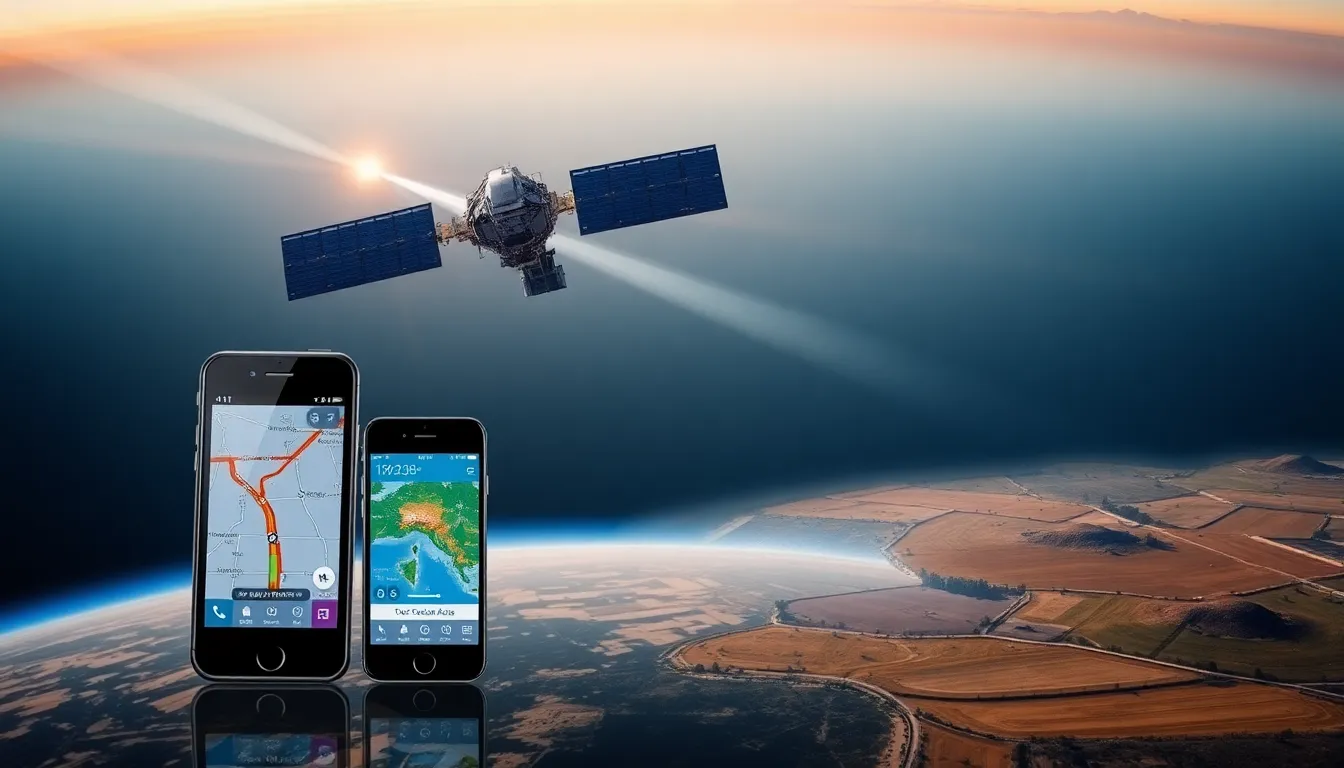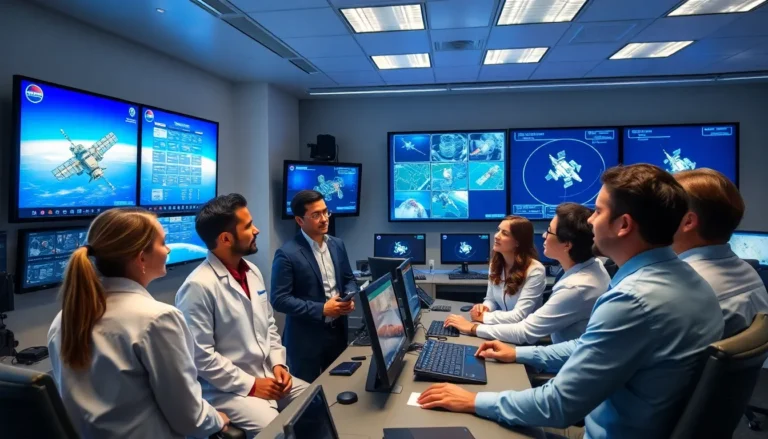Space technology isn’t just for astronauts and rocket scientists anymore. It’s woven into the fabric of daily life, often without anyone realizing it. From the GPS guiding drivers through traffic to the satellite imagery that helps weather forecasts stay accurate, these innovations are as common as morning coffee. Who knew that the same tech that sends rovers to Mars also keeps our lives running smoothly on Earth?
Table of Contents
ToggleOverview Of Space Technology
Space technology encompasses various systems and applications that emerge from scientific research and advancements in space exploration. It finds its way into everyday life, often without individuals recognizing its significance. Satellite communications enable global connectivity, forming the backbone of modern telecommunications.
Global Positioning System (GPS) technology plays a pivotal role in navigation, guiding millions daily using data from satellites to determine precise locations. Weather forecasting relies heavily on space technology; meteorologists utilize satellite imagery to monitor atmospheric conditions, predicting storms and changes in weather patterns with greater accuracy.
Health monitoring devices benefit from space technology too. Advanced imaging technologies, originally developed for space missions, enhance medical diagnostics and treatments. Innovations in materials science, driven by challenges in space, lead to the development of durable products that improve safety and efficiency in numerous industries.
Agriculture also reaps advantages from space technology. Remote sensing helps farmers optimize crop management, enhancing yield and sustainability. Additionally, transportation sectors utilize satellite data to improve logistics, reduce fuel consumption, and enhance route efficiency.
Understanding the applications of space technology in daily life underscores its vital role in advancing society, improving communication, enhancing safety, and supporting economic growth. This technology transforms how people interact with their environments, showcasing its importance beyond mere exploration of the cosmos.
Impact On Communication

Space technology significantly enhances communication in everyday life. It connects people across the globe, making instant interactions possible.
Satellite Communication
Satellite communication systems facilitate real-time voice, video, and data transmission. These systems support telecommunications, broadcasting, and internet services. Satellite networks ensure connectivity in rural and remote locations, where traditional infrastructure may be inadequate. For instance, companies like SpaceX and OneWeb are expanding internet access through low Earth orbit satellites. Users benefit from reliable service even in challenging terrains. Satellites also support emergency communications during disasters, providing critical links when terrestrial networks fail. Overall, satellite communication remains essential for modern connectivity.
Global Positioning System (GPS)
GPS technology plays a crucial role in navigation and location-based services. GPS devices allow users to determine precise locations, enhancing travel experiences and safety. Smartphone applications utilize GPS data for navigation, offering real-time directions and traffic updates. Delivery services rely on GPS to optimize routes, improving efficiency and reducing costs. Fleet management benefits from GPS tracking, enabling businesses to monitor vehicle locations and streamline operations. Various industries, including agriculture and construction, leverage GPS for surveying and land management. The widespread adoption of GPS demonstrates its importance in daily life.
Advancements In Weather Forecasting
Space technology significantly enhances weather forecasting, crucial for daily life. Meteorologists utilize advanced tools to predict weather patterns and monitor atmospheric changes.
Remote Sensing Satellites
Remote sensing satellites provide real-time data on weather conditions and environmental changes. By capturing images and measurements from space, these satellites improve forecasting accuracy. An example includes the National Oceanic and Atmospheric Administration’s (NOAA) GOES satellite series, which detects severe weather events. Data from these satellites help predict hurricanes and thunderstorms, allowing communities to prepare effectively. Also, satellites observe natural disasters, aiding in emergency response and resource allocation.
Climate Monitoring Technologies
Climate monitoring technologies, derived from space exploration, track global climate changes over time. Satellites like NASA’s Landsat gather long-term data on land use, vegetation, and temperature variations. This information supports climate models that predict future trends. Technologies also enable scientists to monitor greenhouse gas emissions from space, assisting in efforts to combat climate change. By providing vital information on atmospheric composition, these technologies guide policy decisions aimed at sustainable development and environmental protection.
Enhancements In Transportation
Space technology significantly enhances transportation, making systems more efficient and reliable. Innovations stemming from space exploration play a crucial role in improving navigation and cargo delivery.
Space-based Navigation
Satellites provide essential data for GPS, allowing users to navigate with precision. Heavily relied upon, GPS systems help vehicles avoid congestion and optimize travel routes. Drivers benefit from real-time traffic updates, while pedestrians use smart devices for directions. Industries leverage GPS for fleet management, streamlining operations and reducing operational costs. Without this technology, modern transportation efficiency would decrease markedly.
Cargo Delivery Systems
Satellite technology has revolutionized cargo delivery systems. Tracking shipments in real-time enables companies to monitor delivery progress and enhance supply chain logistics. Efficient route planning minimizes delays, ensuring timely arrivals. Multiple businesses adopt satellite data to predict and manage shipping challenges. Enhanced visibility also allows for proactive measures in case of disruptions, bolstering reliability in deliveries. Ultimately, space technology contributes to a seamless transportation experience globally.
Applications In Healthcare
Space technology significantly impacts healthcare, enhancing patient care and medical practices. Innovations originating from space exploration provide solutions that improve access to healthcare services and diagnostic techniques.
Telemedicine Innovations
Telemedicine leverages satellite communication for remote consultations and health services. Physicians conduct virtual visits with patients in underserved areas via high-quality video conferencing. This technology eliminates geographical barriers, enabling specialists to reach patients unable to travel. Additionally, real-time data transmission from wearable devices supports continuous health monitoring, allowing timely interventions. Notably, disaster relief operations benefit from telemedicine, providing urgent care to those in crisis zones through satellite connections.
Medical Imaging Technology
Medical imaging technology has advanced due to innovations derived from space missions. Techniques such as MRI and CT scans have benefitted from imaging systems initially developed for space exploration. Enhanced imaging technologies provide clearer images, improving diagnostics and treatment planning. These advancements allow healthcare professionals to detect conditions earlier and with greater precision. Furthermore, satellite-based imaging assists in the analysis of diseases affecting large populations, contributing to public health monitoring efforts. Overall, space-derived technologies transform healthcare delivery and patient outcomes.
Space technology has seamlessly woven itself into the fabric of everyday life. Its applications enhance various aspects of daily activities from navigation to healthcare. The innovations derived from space exploration not only improve efficiency and safety but also foster global connectivity.
As society continues to benefit from these advancements, understanding their origins in space technology highlights the importance of continued investment in research and development. The ongoing evolution of these technologies promises to further enrich lives and address challenges on Earth. Embracing this connection to space can inspire future innovations that will shape a better world.




